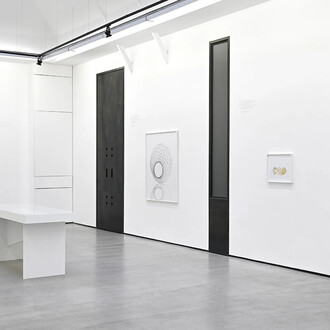The exhibition Orlan toute(s) / All (ways) explores the artist’s multiplicity: by borrowing the phrase en avant toute (All the way), which suggests movement and momentum, but also by putting the plural in parentheses, this title underlines Orlan’s fluid identity, which shows through her works and elsewhere. "I-we," "I am Orlan among others, and to the best of my ability," "I am both a woman and a man": these are expressions the artist has used to continuously reinvent herself. Since her earliest works in the 1960s, she renamed herself "Orlan" (after trying "Or-lent" and "Orl’an"), thus distancing herself from her biological heritage and rejecting the name of her father—an attempt to escape from patriarchy. Furthermore, since the 1990s, Orlan has denounced the concept of the innate and its relationship with norms, claiming that the human body had become obsolete and that "anatomy was no longer a destiny." This approach reached its peak during her surgical performances, when her face became a kind of image or mask that could be removed and put on at will.
The exhibition presents nearly sixty years of self-portraiture. Orlan’s early photographic works, the Corps sculptures (Sculpture bodies), show the metamorphosis of her body into sculpture through a play of light and shadow. The exhibition also features exclusive photographs from the same period, in which the artist adopts various stereotypical "feminine" magazine poses, but shot in what seems to be an artist’s studio, thus blending "high art" with pop imagery. Starting in the 1970s, Orlan developed a new relationship with photography through incorporating performances: MesuRages consisted in measuring streets named after "great men" or museums, using her own body as a measuring unit, the “Orlan-body”. This allowed her to shed light on power relations between genders embodied in space, but also in literature, through a static version, the Orlan-book-body. By staging herself and revealing her pubic hair in front of a painting in the Louvre (In the buff no bush) or using a reproduction of her own bust to sell kisses or candles to Saint Orlan (the famous Artist’s kiss), Orlan used the dialogue between photography and performance to show what is usually unseen. In a similar spirit, her post-surgical performance photographs reveal what is ordinarily hidden : hematomas, swelling, and post-surgical redness. The fluidity of photographic and performative media thus reflects the fluidity of Orlan’s identity. This reflection also includes her work on baroque drapery, a sort of second skin, with which the artist engages in role play : with Saint Orlan, she explores the logic of the "and" in baroque and the blending of opposites, as is the case here with the association of traditional iconography and contemporary technology (laser beams, video projection, etc.).
Finally, the exhibition showcases the continuation of her exploration of the baroque "and" through recent works that build upon her Self-hybridations series. The artist’s transformation now involves collage, digital photomontage, and “morphing”, blending her own image with icons from art history in preparation for her surgical performances. Her new works continue to play on the concept of hybridization: Orlan merges with Picasso’s style by reinterpreting his portraits of Dora crying, commenting on the role of the muse. She thus pays a feminist tribute to the "forgotten" women of history by revisiting historical portraits. Finally, the artist presents post-human images created using new technologies, blending futuristic innovation with a critique of anthropocentrism: using artificial intelligence, Orlan creates images of robots (in reference to her “Orlanoids”), made from recycled materials, presented alongside endangered animals in their natural habitats. Orlan Toute(s) / All (ways) thus exposes all the transformations and variations of what it could mean, in a world in constant evolution, to be Orlan.
(Text by Quentin Petit Dit Duhal)












